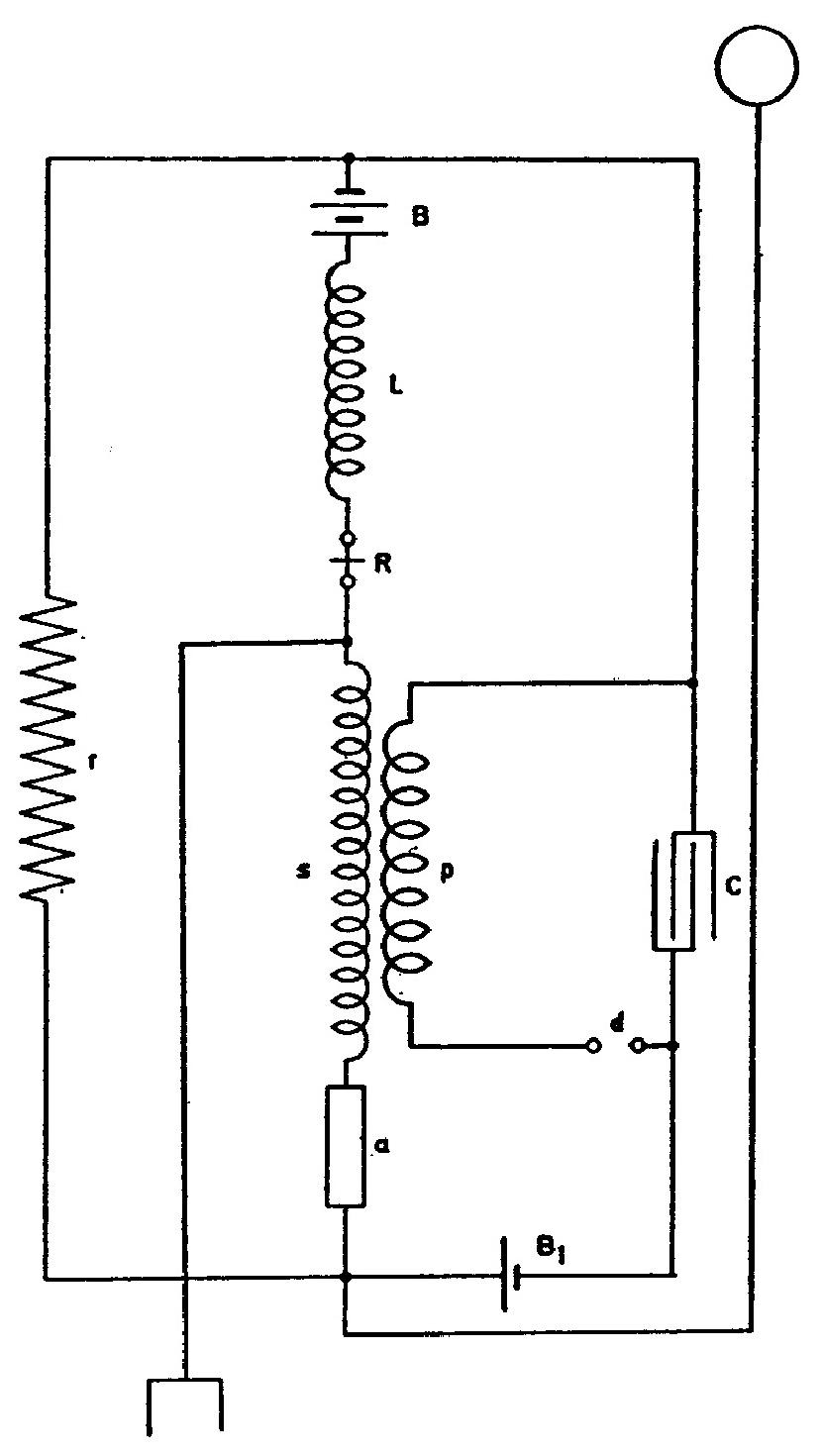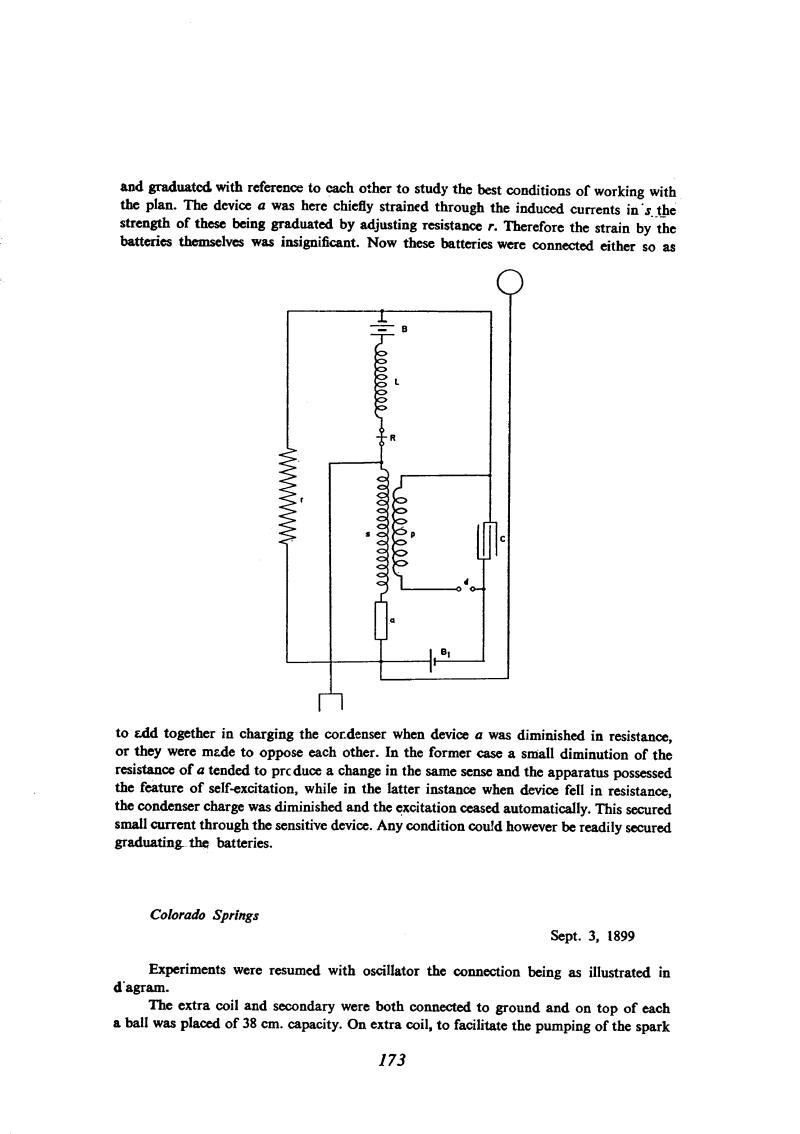
Nikola Tesla Books
and graduated with reference to each other to study the best conditions of working with the plan. The device a was here chiefly strained through the induced currents in s the strength of these being graduated by adjusting resistance r. Therefore the strain by the batteries themselves was insignificant. Now these batteries were connected either so as
to add together in charging the condenser when device a was diminished in resistance, or they were made to oppose each other. In the former case a small diminution of the resistance of a tended to produce a change in the same sense and the apparatus possessed the feature of self-excitation, while in the latter instance when device fell in resistance, the condenser charge was diminished and the excitation ceased automatically. This secured small current through the sensitive device. Any condition could however be readily secured graduating the batteries.
Colorado Springs
Sept. 3, 1899
Experiments were resumed with oscillator the connection being as illustrated in diagram.
The extra coil and secondary were both connected to ground and on top of each a ball was placed of 38 cm. capacity. On extra coil, to facilitate the pumping of the spark
173
September 3-4
The aim of these experiments is not explained, but it was probably associated with the âexperimentalâ coil with which he examined currents in the water pipe. This was a resonant coil which in the receiver played a part analogous to that of the âextraâ coil in the transmitter. Its purpose was to maximize the received signal. Since Tesla connected one terminal to ground, it appears that he wanted to pick up electrical vibrations from the earth. In this case too he found that it was not sufficient just to increase the Q-factor $! {pL \over R} $!, but also that it was necessary to keep the coil's distributed capacity as low as possible. This conclusion was consistent with what he had earlier found about the influence of distributed capacity of the coil on the length of wire needed to achieve resonance. Conclusion (5) is interesting in that it shows Tesla was aware that the secondary and the extra coil, although excited by the same primary, would each oscillate at its own resonant frequency, and if these were not the same, they would beat.
September 3-8
The purpose of these experiments with the oscillator have not been explained, but it is probably related to the "experimental coil" by means of which Tesla tests the currents along a water pipe. The "experimental coil" is a resonant coil which in the receiver plays a similar role as the "additional" coil in the transmitter. The purpose of this coil is the achievement of a maximum incoming signal strength.
On that basis Tesla connects it with one end to the ground. It seems that he wants to receive electrical disturbances from the ground through it. For this coil as well, he draws the conclusion that it is not enough to increase the validity factor $! {pL \over R} $!. but it is also necessary to take care of a reduction in coil capacitance as well. The conclusions are drawn on the basis of coils made from the same wire, but with a different number of turns.
On September 4 he tests the "experimental coil" in order to establish the distributed capacitance effect on the amount of resonant voltage at the coil terminals. The coil is excited via the water pipe to which one lead of the oscillator secondary and one lead of the experimental coil are connected. Coils are mutually positioned so that between them there is no inductive link (refer Fig. 1). The voltage on the experimental coil is measured on the basis of spark lengths, not only between the terminals of this coil but also from each terminal to the body of the experimenter (when actually the body capacitance is added and in a way the resonant conditions are changed). He changes the number of turns of the coil from 448 to 168, then he changes the method of connection of the coils (in order to increase excitation) as per Fig. 2 and performs further measurements reducing the number of turns to 19. The conclusion is in agreement with previous findings about the influence of coil distributed capacitance on the length of the wire necessary to obtain resonance condition. The conclusion under No. 5 is interesting because it indicates that Tesla knew that secondary vibrations and vibrations of the additional coil, if they are not equal, will "pop-up" as if each of them will vibrate according to its own resonant frequency (although they are excited by the same primary). Their sum could be considered as vibration at frequency $! {{\left({f_{1} + f_{2}}\right)} \over 2} $! with a variable amplitude at frequency $! {{\left({f_{1} - f_{2}}\right)} \over 2} $!
On Sept. 5 he performs tests with a new "experimental coil" and changes the measurement method. The spark length is not measured from the terminal to the body, but to various metal globes installed on insulators. The validity factor is estimated on the basis of spark lengths at two coil terminals. Judging on the basis that with these experiments the sparks did not appear between the oscillator globes (Fig. 1), the oscillator operated with small power. Tesla gave particular attention to avoiding the direct link between the "experimental coil" and oscillator primary coil. Because he was convinced that the link is weak, he continued similar experiments outside of the laboratory, holding always one coil's terminal connected to a water pipe. Even at the distance of approximately 120 meters he achieved sparks from the open end of the oscillator circuit to the body of more than 1 cm in length.
After these experiments Tesla again draws the conclusion that the distributed coil capacitances are of big harm, and he decided to make the coils with minimum capacitance. Unfortunately he does not explain how he achieved that. Because he decided to achieve the maximum voltage on the coil, Tesla went even so far that he considered it was best when there is no capacitance at the open end. On one side Tesla was right (because according to theory with minimum capacity in a resonant circuit it is possible to achieve the maximum validity factor of the coil, but "without elevated" metal globe the received signal is considerably reduced due to elimination of the monopole aerial at the open coil's end. In a practical circuit, however (Sept. 5, Fig. 3) Tesla does not get that close to the limit. He adds "experimental coil", but he left the metal globe (air capacitance) connected to one end of the sensitive device.
On Sept. 6 he puts an additional oscillating circuit in the vicinity of the oscillator secondary by means of which he wants to produce short waves (please see the Fig.) When calculating the wavelength of the cable vibrations with the globe one error sneaked in. Because the calculated T (wave length) has to be approximately ten times shorter and with regard to that, the coil he wants to wind has to have 33 turns. Next day he wanted the coil with 400 turns.
After the experimental checking of resonant frequency he found an approximate twelve times smaller value than the one he calculated on Sept. 6. In order to make sure that it is not a question of harmonic frequency, he was reducing the coil's number of turns. He concluded that after reducing the number of turns to less than 270, the spark length is continuously reducing as well. Then he made the coil with the thicker wire and achieved somewhat longer sparks. Next he unwound the coil again and achieved the longer spark with approximately the same number of turns as in the first experiment with thinner wire. The experiments were finished that day without definite conclusions.
On Sept. 8 he again wound a new coil, this time he performed the calculations and inductance measurements and he found the agreement between theory and experiments.


